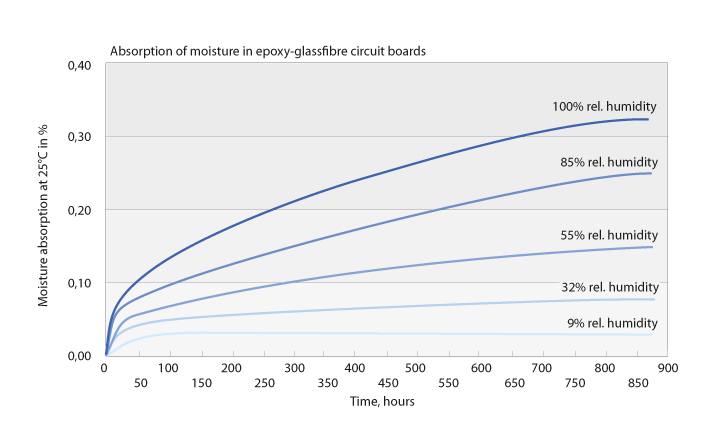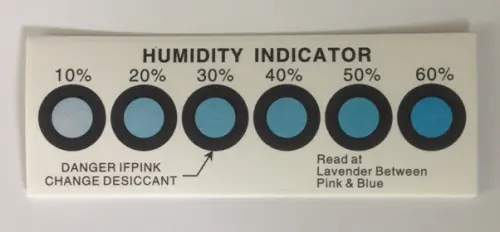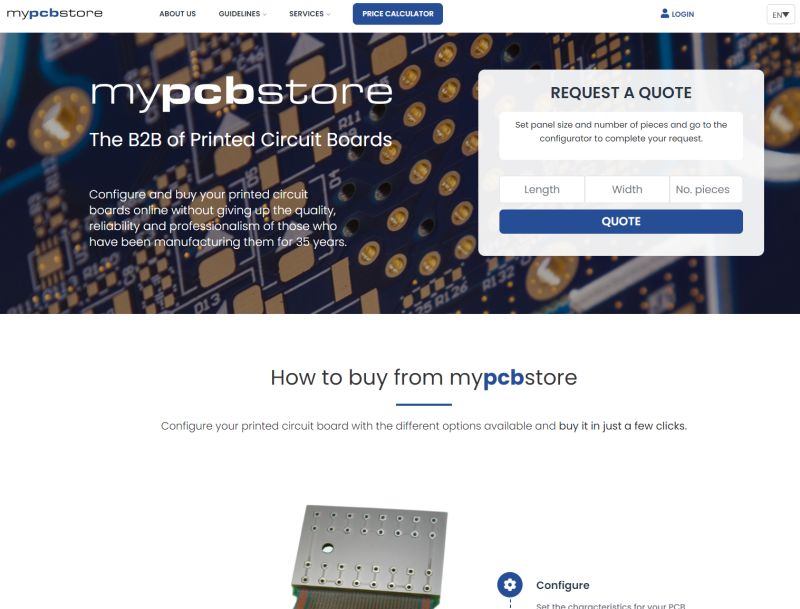Storage recommendations
All PCBs are hygroscopic and multilayerMultilayer (Mehrschicht-Technologie):Die Multilayer-Technolo… More and thin PCBs in particular are very sensitive to their moisture content, i.e. moisture is absorbed into the intermediate layers even under normal room conditions. Moisture in materials leads to undesirable generic quality defects, especially at high temperatures.
Under storage conditions of 20 degrees Celsius and 50% humidity, a moisture absorption of 0.12% (in percent by weight of the epoxy resin) is achieved just 12 days after unpacking. However, this also increases the gas pressure inside the circuit board, which is caused by strong heating of the material during the soldering process. If the moisture absorption exceeds 0.17%, a critical gas pressure of 8 – 10 bar is reached, at which delamination and bubble formation can occur.
The hygroscopic properties of flexible and rigid-flex printed circuit boards based on polyimide in particular are extremely pronounced. A dried polyimide film absorbs moisture again immediately after drying and has reached its saturation level of moisture again after just a few hours.
These storage recommendations are based on the IPC-1602 guidelines.
Storage conditions
Printed circuit boards should generally be stored in airtight packaging, in a dry and heated environment, whereby a constant temperature must be ensured until shortly before soldering/wetting. A rapid drop in temperature of more than 7° Celsius can lead to condensation on the packaged circuit boards. The following recommendations apply for uncontaminated ambientUmgebung
Bezeichnung für die Bauteilumgebungsluft zur De… More air:
Storage temperature: 18-22°C; Air humidity: 30-50% rel.

Shelf life
The storage time of printed circuit boards should be as short as possible. The board is best consumed according to the FIFO principle (“first-in, first-out”). Please also note the information on “Shelf life” in the Surfaces section.
Soldering test
Printed circuit boards that have been stored for a longer period of time and whose transportation circumstances cannot be conclusively clarified (the goods are transported by the shipping company at any temperature and in any weather) should definitely be subjected to a soldering test. If possible, this should correspond to the circumstances of the soldering process intended for the circuit boards.
Drying
Regardless of the outcome of a soldering test, we recommend – mainly for multilayerMultilayer (Mehrschicht-Technologie):Die Multilayer-Technolo… More and especially for flexible and rigid-flex PCBs – drying the PCBs in a convection oven to reduce the humidity absorbed in the PCBs.
The moisture is distributed in the material with accumulations at the boundary layers. During the soldering process, the absorbed moisture can lead to damage through delamination, blistering, tearing, etc. The risk of delamination increases exponentially with the soldering temperature.
We recommend that drying and logistics are prescribed and specified in the PCBauch: gedruckte Schaltung, engl.: PCB – Printed circuit boar… More drawing documents
The PCBs should be dried individually, vertically in a rack with sufficient space between them; not in a stack! This measure increases production reliability for all types of PCBs.
Drying results can be improved if care is taken during the design phase to avoid using copper surfaces over the entire surface.
Tempering
By definition, there is indeed a difference between drying and tempering. Tempering is the heating of printed circuit boards at elevated temperatures immediately before the soldering process. As the recommendation, especially for flex and rigid-flex PCBs, is to start processing immediately after drying, these two terms have merged.
The tempering process is used in PCBauch: gedruckte Schaltung, engl.: PCB – Printed circuit boar… More production to reduce stresses. Such stresses can be seen in the twisting and warping of printed circuit boards. For this purpose, a temperature above the TgDie Glasübergangstemperatur (Tg) ist eine wichtige Kenngrö… More (glass transition value) must be selected, while drying is carried out at a lower temperature (see table below).
Guide values for drying times
| Temperature | 1-/2-Layers | Multilayer | Flex/Rigidflex |
|---|---|---|---|
| 120°C | 2-3 hours | >3 hours | >5 hours |
| 100°C | >5 hours | >5 hours | >8 hours |
| Processing* | within 48 hours | within 8 hours | immediately! |
The drying recommendation according to IPC/JPCA-6202 for external flex layers: 2h at 120°C
Design recommendation
Install drying openings in the design:
To allow moisture to escape during the drying process, it is recommended to lay out drying openings in the copper surfaces for ground and shielding layers not only for flex and rigid-flex, but also for rigid areas!
Design recommendation for drying openings: 1/3 of the area
Attention!
The effect of heat during drying causes some soldered surfaces to age artificially.
This can have a negative effect on soldering behavior and wetting, especially with immersion tin and OSP. Fewer disadvantages are to be expected with the standard ENIG and HASL surfaces.
In principle, temperature profiles that are as gentle as possible on the material should be selected for soldering and drying. Even small differences can have a decisive influence on the result in borderline cases.
It is essential to ensure that the drying ovens are clean and that no condensate from other dry goods contaminates the soldering surfaces.
Low temperature drying or vacuum drying is not recommended!
Packing
ALBA PCBauch: gedruckte Schaltung, engl.: PCB – Printed circuit boar… More Group printed circuit boards are packaged in shrink-wrapped polyethylene packaging on PLURIBALL films with a desiccant bag (DMF-free) and a humidity indicator card (HIC) with 6 highly sensitive indicators (display delay less than 24 hours).
The plastic packaging used (which is free of aluminum incorporated into the polyethylene) is not an effective moisture barrier bag within the meaning of IPC 1602.
Regarding the WVTRwater vapor transmission rate
Wasserdampfdurchlässigkeit… More (water vapor transmission rate), the polyethylene film used has an estimated value of 0.1g/100in²/24 hours, calculated at 38 °C and a relative humidity of 90%: The IPC 1601 standard does not provide any precise or binding information on this subject and refers to some types of packaging materials with metal foil content that have a much lower WVTRwater vapor transmission rate
Wasserdampfdurchlässigkeit… More (since it is obviously a metal foil), but which are not used in the usual packaging of printed circuit boards, which is obviously not dry packaging.

Recommended packing:
Sealed in PE film, air-thick with moisture indicator
The IPC 1601 standard specifies 0.1% accumulated humidity (moisture content max. 0.1%) as the protection threshold for the delamination of printed circuit boards during lead-free soldering. This is particularly important for multilayerMultilayer (Mehrschicht-Technologie):Die Multilayer-Technolo… More PCBs (and double-sided PCBs with a thickness of less than 1.2 mm).
Moisture indicator
with 6 levels

The humidity indicator cards show the relative humidity (RH) inside the packages, but not the moisture content of the PCBs (which can be both higher and lower compared to the RH inside the package), and they do not have a “recording” function: if the indicator shows a certain percentage of humidity, it means that there is such a percentage of relative humidity inside the package at that time (taking into account the display delays).
If the relative humidity reading is between 30% and 40%, the packaging should be opened, the desiccant replaced and the packaging resealed by inserting a new indicator (or drying the existing indicator so that it returns to lower values and then reinserting it in the packaging), especially if durability could be maintained for a long time under the same conditions before welding (more than 1 month, but this also depends on the environmental conditions of the warehouse where the PCBauch: gedruckte Schaltung, engl.: PCB – Printed circuit boar… More is stored).
In this way, drying of the circuit boards can be avoided for several months.
If the humidity in the packaging is 50% (measured by the indicator), soldering the PCBs may become impossible after about 300 hours (12 days) in this condition. However, this depends on previous storage conditions at lower humidity. The attached graph shows the accumulation of moisture on FR4 printed circuit boards with varying ambientUmgebung
Bezeichnung für die Bauteilumgebungsluft zur De… More humidity, whether inside the closed packaging or outside when it is opened. This allows the possible moisture content (MC) to be assessed.
The shelf life of the printed circuit boards can be assessed on the basis of the relative ambientUmgebung
Bezeichnung für die Bauteilumgebungsluft zur De… More humidity, including opened packaging, provided that the humidity in the warehouse is monitored. The reference point is a maximum moisture content of 0.1%, as mentioned above.
An important note: The absorption curve at a relative humidity of 32% approaches a value below 0.1% asymptotically. This indicates that at less than 32% relative humidity there are no problems with exceeding the MC value even after prolonged exposure. The curve shows stagnation after 800 hours, but the trend shows a clear asymptote.
Especially with multilayerMultilayer (Mehrschicht-Technologie):Die Multilayer-Technolo… More PCBs, it is important to note that if the indicator card shows 50%, a moisture test (MC test) should be carried out before mounting the PCBs or at least a check of the soldering on the first parts to be soldered. If no check is carried out, the soldering process will still continue.
Regarding the drying cycle to be applied to the PCBs to remove excessive moisture content, it is recommended to use 5 hours at 120°C, overlapping the boards as in the packaging (the plastic packaging, indicators and desiccant bags must be clearly removed): this should be considered if the PCBs have a moisture content of more than 0.1%.
A possible simple test is that of IPC TM 650 2.6.28 which only needs to be performed on one PCBauch: gedruckte Schaltung, engl.: PCB – Printed circuit boar… More of the batch to be evaluated from a closed package: Note that the same test is carried out by the Alba PCBauch: gedruckte Schaltung, engl.: PCB – Printed circuit boar… More Group factories on delivery and the MC value is recorded in our archives (for each batch), in addition to carrying out the thermal stress test for delamination.
It should also be noted that the drying process should be carried out close to the soldering process (a few hours or a maximum of 1 day before) and should not be seen as a long-term pre-treatment for the soldering process.



